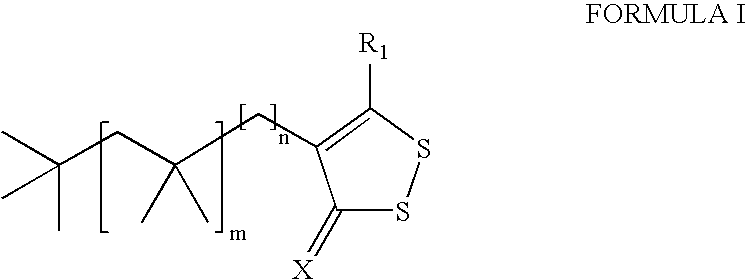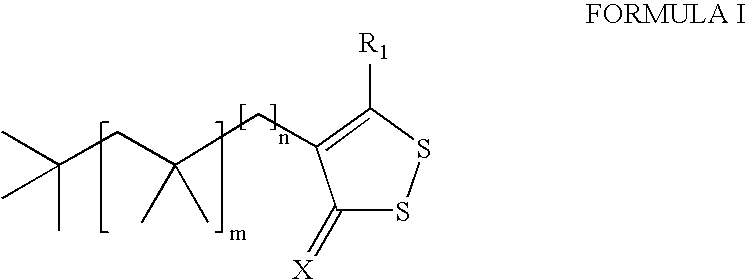Sulfurized polyisobutylene based wear and oxidation inhibitors
- Summary
- Abstract
- Description
- Claims
- Application Information
AI Technical Summary
Benefits of technology
Problems solved by technology
Method used
Image
Examples
examples
[0060]The following examples are included to demonstrate preferred embodiments of the invention. It should be appreciated by those of skill in the art that the techniques disclosed in the examples that follow may represent techniques discovered by the inventor to function well in the practice of the invention, and thus may be considered to constitute preferred modes for its practice. However, those of skill in the art should, in light of the present disclosure, appreciate that many changes may be made in the specific embodiments that are disclosed and still obtain a like or similar result without departing from the spirit and scope of the invention.
example 1
[0067]Preparation of polyisobutyl-1,2-dithiole-4-cyclopentene-3-thione “PDCT” mixtures from a high methyl vinylidine C8-C32 polyisobutene fraction.
[0068]1904.8 g (I0.7 mol) of a high methyl vinylidine content low molecular weight PIB having a number average molecular weight of 178, approximately 74% methyl vinylidine content (and a weight fraction of each oligomer of approximately 16 wt. % C8H16, about 41 wt. % C12H24, about 26 wt. % C16H32, about 11 wt. % C20Hwt. % C24H48, and about 2 wt. % C28H56 with trace amounts of C32H64 as characterized by gas chromatography and nuclear magnetic resonance spectroscopy) and 1017.5 g of elemental sulfur were charged to a 5 liter stainless steel autoclave. The autoclave was flushed with nitrogen, and then sealed. The reactants were stirred and heated to 200° C. over about 2 hours. The temperature was then maintained between 200 and 220° C. under autogenous pressure for 3.5 hours such that the pressure in the autoclave did not exceed 200 psia. Th...
example 2
[0069]Preparation of PDCT mixtures from a high methyl vinylidine C12-C32 polyisobutene fraction:
[0070]497.4 g (2.5 1 mol) of a low molecular weight polybutene that had been distilled to remove the C8 isomers, having a number average molecular weight of 198 and 73% methyl vinylidene content, and 201 g of sulfur were heated and stirred, under a nitrogen atmosphere, in a 3 neck glass round bottom flask equipped with a mechanical stirrer, heat mantle, thermocouple, temperature controller, reflux condenser, nitrogen inlet, and caustic scrubber. A gentle sweep of nitrogen was continuously passed through the vessel and scrubber. The reactants were heated to reflux, at about 180° C., then slowly heated to 200° C. over a total of about 1 hour; they were held at 200° C. for about 20 minutes, then heated at 220° C. for 2.5 hours. After cooling to room temperature the product was diluted with 400 ml of heptane and filtered through diatomaceous earth. The solvent was removed to yield 447.4 g of ...
PUM
| Property | Measurement | Unit |
|---|---|---|
| Temperature | aaaaa | aaaaa |
| Fraction | aaaaa | aaaaa |
| Fraction | aaaaa | aaaaa |
Abstract
Description
Claims
Application Information
 Login to View More
Login to View More - R&D
- Intellectual Property
- Life Sciences
- Materials
- Tech Scout
- Unparalleled Data Quality
- Higher Quality Content
- 60% Fewer Hallucinations
Browse by: Latest US Patents, China's latest patents, Technical Efficacy Thesaurus, Application Domain, Technology Topic, Popular Technical Reports.
© 2025 PatSnap. All rights reserved.Legal|Privacy policy|Modern Slavery Act Transparency Statement|Sitemap|About US| Contact US: help@patsnap.com



